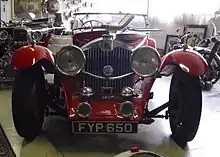Autovia
Autovia was a short lived brand of British car from Coventry existing from 1935 to 1938 with production starting in January 1937.[2] The venture was ambitious and even included setting up a school for chauffeurs. The cars were expensive and it was a market sector well served by other companies. 44 cars were made.[6]
| Autovia | |
|---|---|
.jpg.webp) limousine by Arthur Mulliner EYX 464 registered September 1938 | |
| Overview | |
| Manufacturer | Autovia Cars Limited,[note 1] Ordnance Works, Midland Road, Foleshill, Coventry CV6 5DX |
| Production | 1937-1938 public sales starting 1936[1][2] 44 made |
| Designer | Charles Van Eugen (1890-1980) |
| Body and chassis | |
| Class | Large luxury |
| Body style | chassis 4-light sports saloon 6-light saloon limousine[2] |
| Layout | Front engine rear wheel drive |
| Related | (engine) Riley 1½-litre straight 4 and Riley 8/90 2¼-litre 90°V8[3] |
| Powertrain | |
| Engine | 2,849 cubic centimetres (174 cu in) 90°V-8 |
| Transmission | single dry-plate clutch to a 4-speed manual gearbox with synchromesh on all speeds or automatic clutch and 4-speed preselective gearbox divided propellor shaft, back section in a torque tube final drive by underhung worm is housed in a banjo-type casing[2] |
| Dimensions | |
| Wheelbase | 129 in (3,300 mm)[4] |
| Length | 175.5 in (4,460 mm) or 183 in (4,600 mm)[4] Track 56.5 in (1,440 mm) |
| Width | 71 in (1,800 mm)[4] |
| Chronology | |
| Predecessor | none |
| Successor | none |
| Overview | |
|---|---|
| Production | 44 |
| Layout | |
| Configuration | 90°V-8 |
| Displacement | 2,849 cubic centimetres (174 cu in)[2] |
| Cylinder bore | 69.5 mm (2.74 in)[2] |
| Piston stroke | 95.25 mm (3.750 in)[2] |
| Valvetrain | inclined at 90° overhead valves worked by pushrods from three camshafts[2][5] |
| Combustion | |
| Fuel system | twin Zenith downdraught carburettors with a balance pipe and hot-spot fed from a 16 gallon tank at the back, ignition by magneto with automatic advance mounted vertically towards the rear of the V[2][5] |
| Cooling system | a water pump is mounted either side of the timing case. The radiator has a fan and thermostatically controlled shutters. The sump is ribbed at the sides[2][5] |
| Output | |
| Power output | 99 bhp @ 4,700 rpm[3] Tax rating 23.8hp[2] |
| Chronology | |
| Predecessor | Riley 8/90 2¼-litre 90°V8[3] |
| Successor | none |
_limousine_EYX_464.jpg.webp)
No higher resolution available
Large luxury cars
The company was created by Riley as a subsidiary to produce large luxury cars and a new factory was built. A 2849 cc 90°V-8, triple camshaft engine was developed from a pair of 1½-litre Riley engine blocks and coupled to a pre selector unit bought from Armstrong Siddeley. One car was fitted with a zf 4 speed manual box, Drive was to the rear wheels through a live axle with worm gear final drive.
Three body types were advertised, a Sports saloon, a Special Saloon with extra leg room at the expense of boot space and a limousine mostly built by Arthur Mulliner of Northampton who were London distributors. The car was also available as a bare chassis.
The venture failed when Riley went bankrupt. When they were taken over by the Nuffield Organisation Autovia was not resurrected.
There were thought to be eight of these cars remaining in 2008.[7]
The limousine was considered remarkable for its width being more than its overall height yet the floors were flat and a tunnel and wells avoided at the back. "The general low set helps stability" said The Times, "the models are well equipped, as they should be for the price".[2]
 Open two-seater originally a saloon registered September 1939 |
Specification
The specially designed chassis frame permits a low overall height and low floor line.[2]
In addition to the details in the adjacent box:
- wheels: Dunlop centre-lock wire 3.50" x 19"[3] with nave plates
- tyres: 5.5" section on 19 inch wheels[2][3]
- suspension by semi-elliptic springs from the two rigid axles is controlled by hydraulic shock absorbers, their resistance is controlled by the driver[2]
- braking on all four wheels is mechanically actuated[2] by rods with wedge operated shoes in 16 inch drums[3]
- steering by worm and nut[2]
- lubrication (of chassis items) is centralised and automatic[2]
Pricing
In a prior announcement 10 October 1936 Victor Riley revealed there would be two models available in addition to the bare chassis all with an automatic clutch, a preselective gearbox and a worm driven back axle. Prices would be:
- chassis £685
- five-seat saloon £975
- limousine £995
The London distributors were Arthur Mulliner Limited of 54 Baker Street.[8]
Notes
- Autovia Cars —Manufacturers of and dealers in and hirers of automobiles, motor vans, and lorries, &c.
Nominal capital, £60,000, in £1 shares.
"Company Registrations". The Times (47249). 17 December 1935. p. 21.
References
- Sedgwick, M. (1989). A-Z of Cars of the 1930s. Devon, UK: Bay View Books. ISBN 1-870979-38-9.
- The Times, Wednesday, 22 September 1937; pg. 6; Issue 47796
- Rileyrob. "Autovia (1937-38)". Retrieved 2 February 2014.
- Culshaw; Horrobin (1974). Complete Catalogue of British Cars. London: Macmillan. ISBN 0-333-16689-2.
- "The Motor Show". The Times (47819). 19 October 1937. p. 10.
- Autovia Car Club
- Hardiman, Paul (February 2008). Duchene, Paul; Lombard, Stefan; Pickering, Jim (eds.). "H&H Auctions, Duxford, UK: The Imperial War Museum". Sports Car Market. Portland, OR USA: Automotive Investor Media Group. ISSN 1527-859X. Retrieved 2 February 2014.
- The Times, Saturday, 10 Oct 1936; pg. 6; Issue 47502
External links
| Wikimedia Commons has media related to Autovia vehicles. |